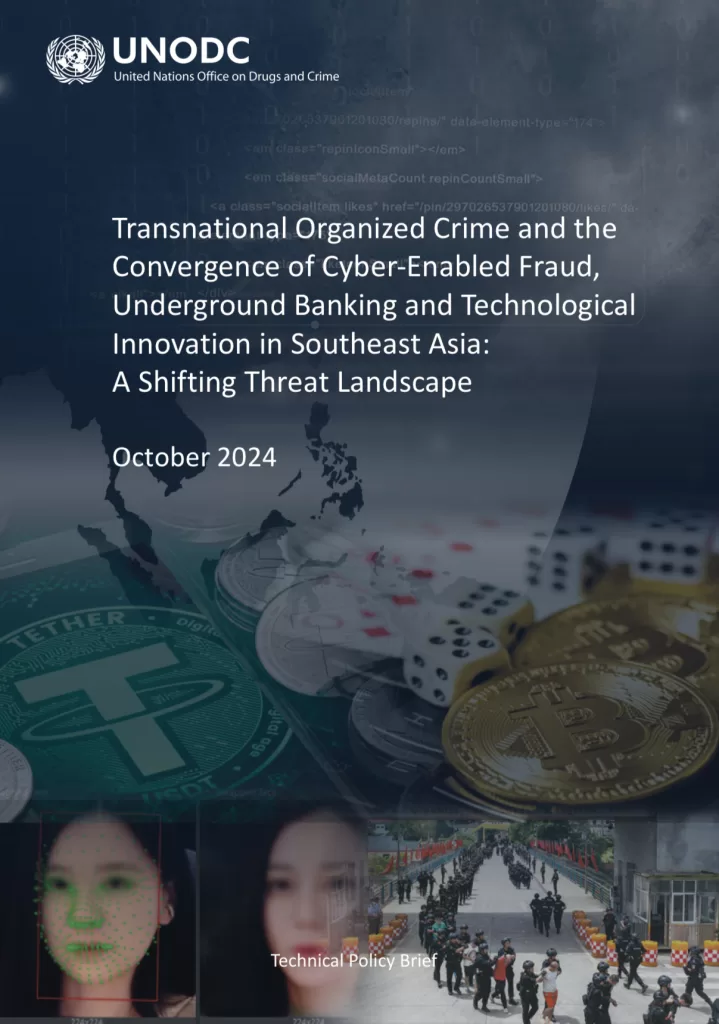In a region where data flows faster than the monsoon rains and cybercriminals lurk like digital pirates, the Asia-Pacific cyber insurance market is in a race to catch up. The game is on, and with cyber-attacks surging by nearly 50% annually, APAC is poised to secure its slice of the global cyber insurance pie. According to the “Protecting the Digital Revolution: The State of the Asian Cyber Insurance Market in 2024” report from Gallagher Re, this fast-growing market now commands 7% of the global share. Yet, while Thailand’s and Vietnam’s economies are plugging into the digital future, their cyber insurance penetration still lags significantly behind that of more developed markets like the United States. And as these countries move online, a new threat emerges—one that stretches far beyond cyber risk coverage.
The UN’s “Transnational Organized Crime and Convergence of Cyber-Enabled Fraud, Underground Banking, and Technological Innovation in Southeast Asia” report sheds light on the rising tide of cybercrime syndicates, creating fresh dangers for economies striving to keep pace with digital innovation. While growth opportunities in cyber insurance are immense, the lurking risks are just as real.

APAC’s Cyber Insurance Growth: Opportunities and Challenges
The Asia-Pacific (APAC) cyber insurance market has rapidly transformed over recent years, driven by the widespread digitalization of economies throughout the region. Gallagher Re’s 2024 report outlines that rising digital activity has fueled an increase in sophisticated cyber-attacks and led to the implementation of stricter data protection regulations. This has, in turn, fueled a surging demand for cyber insurance, growing nearly 50% annually. By early 2024, the APAC region had claimed 7% of the global cyber insurance market, though Gallagher Re highlights the vast room for further expansion, particularly in emerging markets like Thailand, Malaysia, and Vietnam, where cyber insurance penetration rates remain considerably lower than in developed regions like North America.

Growing Awareness and Regulatory Frameworks
Key drivers of this market expansion are the growing awareness of cyber threats and regulatory frameworks that require companies to have robust cybersecurity measures in place. Countries like Singapore and China have led the way, compelling businesses to purchase cyber insurance to meet compliance obligations. The Gallagher Re report notes that while significant opportunities exist in the APAC market, challenges remain—chief among them being the lack of standardized policy wording and the inherent complexity of underwriting fast-evolving cyber risks. As businesses face increasingly diverse threats, reinsurance has become vital in enabling insurers to take on more complex risks in this dynamic landscape.
Despite the tremendous growth prospects, the APAC cyber insurance market faces several challenges that must be addressed. A lack of standardization across different markets makes it difficult for businesses to compare and select appropriate coverage. Moreover, the fast-paced evolution of cyber risks—with new threats like ransomware and supply chain attacks appearing frequently—adds a layer of complexity to the underwriting process. To tackle these challenges, reinsurance plays a critical role, helping insurers manage the financial risks of large-scale cyber incidents and supporting the continued growth of the market. As the region’s digital economy expands, addressing these challenges will be crucial to ensuring businesses are adequately protected.
As the Gallagher Re report emphasizes, the APAC region is poised for substantial growth in cyber insurance. Emerging markets offer particularly ripe opportunities for increased penetration, while more mature markets continue to refine and enhance their cybersecurity frameworks. However, the region’s evolving digital landscape also presents significant risks, particularly in Southeast Asia, where the convergence of technology, crime, and financial flows is reshaping the region’s security ecosystem.
A Hotspot for Cybercrime Syndicates
This context sets the stage for the recent UN report, “Transnational Organized Crime and Convergence of Cyber-Enabled Fraud, Underground Banking, and Technological Innovation in Southeast Asia: A Shifting Threat Landscape,” published in October 2024. This comprehensive report highlights how cybercrime is evolving in Southeast Asia, focusing on the intersection of cyber-enabled fraud, illicit financial flows, and underground banking. The report paints a stark picture of how transnational crime syndicates are increasingly professionalizing their operations, exploiting technology to expand their reach. These syndicates have found fertile ground in Southeast Asia’s border regions and special economic zones (SEZs), where governance challenges provide ideal conditions for illicit activities.

Southeast Asia, part of the broader APAC region, faces distinct cybersecurity challenges that align with many trends observed in the Gallagher Re analysis. Criminal networks in the region are increasingly sophisticated, leveraging cutting-edge technologies such as artificial intelligence (AI) and cryptocurrencies to automate and scale their operations. These technologies enable them to operate across borders, evading law enforcement and creating global fraud networks. For instance, virtual asset service providers (VASPs) and stablecoins like Tether (USDT) have become crucial tools for laundering billions of dollars in illicit funds, seamlessly integrating criminal proceeds into the formal economy with little scrutiny.
Regulatory and Law Enforcement Challenges
The UN report further emphasizes how Southeast Asia has become a testing ground for these criminal innovations, particularly in SEZs, where minimal oversight has allowed illegal activities to thrive. These regions have become hubs for cyber-enabled fraud, money laundering, and illegal gambling, with financial losses estimated between $18 billion and $37 billion in 2023 alone. The report also highlights the growing use of AI and deepfake technology in cyber-enabled fraud, noting a 1,530% increase in incidents between 2022 and 2023. Criminals are increasingly leveraging these technologies to deceive victims with highly convincing fraudulent content, complicating the efforts of law enforcement to keep pace.
The Role of Cryptocurrency in Illicit Financial Flows
In addition to rising cyber-enabled fraud, the UN report outlines the role of underground banking and cryptocurrency in facilitating illicit financial flows across borders. The proliferation of unauthorized and high-risk VASPs in Southeast Asia has further complicated efforts to track and dismantle criminal networks. The ability of criminals to move vast sums of money via cryptocurrencies without attracting scrutiny poses significant challenges for governments and regulators.
As detailed in the UN report, the convergence of cybercrime and technological innovation in Southeast Asia mirrors many of the trends observed in the broader APAC cyber insurance market. Both reports underscore the critical need for comprehensive regulatory frameworks and robust law enforcement capabilities to address these evolving threats. Enhanced intelligence-sharing platforms, stronger regulations, and improved capacity-building efforts are essential to combating the rise of cyber-enabled fraud and underground banking in Southeast Asia.
The Gallagher Re report on the APAC cyber insurance market and the UN’s analysis of cybercrime in Southeast Asia paint a vivid picture of the region’s shifting threat landscape. As governments and businesses across the region continue to navigate the challenges posed by cyber-enabled fraud and other digital threats, the need for robust risk management strategies, including comprehensive cyber insurance solutions, has never been more apparent. The evolving nature of these threats demands constant vigilance, cross-border collaboration, and innovative approaches to regulation and law enforcement. By integrating cyber insurance into broader risk management frameworks, APAC can better protect itself from the financial and operational impacts of cybercrime, ensuring a more secure digital future.
Other News: Ransomware attack impacts 237,000 Comcast customers.
